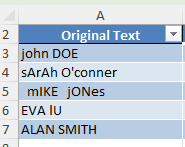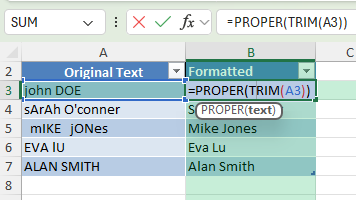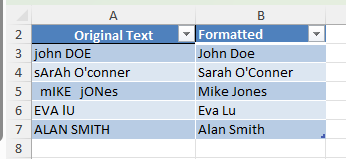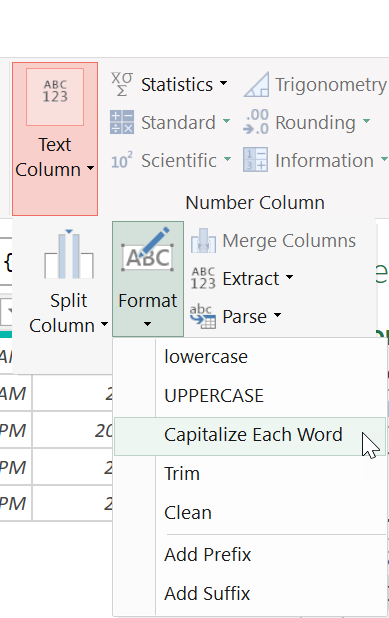When you’re working with names, titles, or product labels in Excel, proper formatting can make a big difference. You may receive messy data where everything is in uppercase, lowercase, or a mix. If you want each word to begin with a capital letter while you convert to lower case—like “John Doe” or “New Product Launch”—you’re looking to apply proper case formatting.
In this guide, we’ll show you how to convert text to proper case in Excel using formulas, helper columns, and VBA. You’ll also get tips for edge cases like extra spaces and apostrophes, plus a downloadable workbook with examples and ready-to-use code.
Key Takeaways
- Use PROPER() to capitalize the first letter of each word
- Wrap PROPER() in TRIM() to remove extra spaces
- For special cases (e.g., names like “O’Conner”), additional cleanup or VBA may be needed
- Helper columns can make complex transformations easier to manage
- VBA is the best solution when you need full formatting control
Table of Contents
Mastering Text Conversion in Excel
Why Capitalizing the First Letter Matters
Capitalizing the first letter of words or sentences in Excel is more than just a stylistic choice; it plays a critical role in ensuring data consistency and readability. Proper capitalization improves the visual appeal and professionalism of documents, making them easier to read and understand. This is particularly important when sharing spreadsheets with colleagues or clients, as it reflects attention to detail and enhances the overall presentation. Moreover, accurately capitalized text can improve the accuracy of data analysis since consistent data entry is crucial for avoiding errors.
Common Scenarios for Text Conversion
Several scenarios might require you to convert text in Excel to capitalize the first letter. One common situation is when importing data from external sources where the text format does not meet the required standard. For example, addresses or names downloaded from a CRM database might be in all caps or lowercase, necessitating a cleanup for uniformity.
Another scenario is preparing a sales report or proposal, where proper noun capitalization is essential. Similarly, if you’re dealing with product names or titles that need to stand out in an inventory list or catalog, ensuring correct capitalization can make them more recognizable and attractive.
Lastly, text conversion is crucial when creating dashboards or presentations, as clean and correctly formatted text helps in conveying information clearly and effectively.
Step-by-Step: Convert to Proper Case in Excel
Step 1 – Prepare Your Raw Data
In Column A, enter names or text with mixed or incorrect casing
Step 2 – Apply the Formula
In cell B2, enter the following formula:
=PROPER(TRIM(A3))
- TRIM() removes leading, trailing, and extra internal spaces
- PROPER() capitalizes the first letter of each word and lowers the rest
You now have your formatted text!
Strategies Beyond Standard Functions
Crafting VBA Macros for Advanced Control
For those seeking greater control over text conversion in Excel, VBA (Visual Basic for Applications) macros offer a powerful solution. VBA allows you to automate repetitive tasks, making it ideal for situations where the built-in functions fall short or for handling large datasets.
Creating a VBA macro to capitalize the first letter involves writing a simple script, which gives you the flexibility to modify and expand as needed. This can save time, especially when dealing with complex spreadsheets or when multiple columns need formatting.
Here’s a brief outline of what a VBA macro might include:
- Open the VBA Editor: Access it via the Developer tab in Excel.
- Write the Script: Use a script that loops through your selected range, applying the capitalization to the first letter.
- Run the Macro: Execute your macro on any dataset effortlessly.
Benefits of using VBA macros include customized automation, increased efficiency, and the ability to apply specific rules beyond standard capitalization. However, they do require an initial time investment to set up and may need some basic programming knowledge.
VBA macros are best suited for advanced users comfortable with the Excel environment and those dealing with regular text conversion needs.
Leveraging Add-ins for Effortless Conversion
For users looking to streamline the text conversion process without diving into code, Excel add-ins present an excellent alternative. These third-party tools enhance Excel’s functionality by providing features specifically designed for tasks like capitalizing the first letter of text.
Add-ins can be easily integrated into Excel and typically offer a user-friendly interface that simplifies complex actions. For instance, you can find add-ins that provide one-click solutions for transforming text into title case, sentence case, or capitalizing the first letter of each word.
The benefits of using add-ins include:
- Ease of Use: Most add-ins require minimal setup and offer intuitive controls.
- Time Efficiency: They drastically cut down the time spent on manual text formatting.
- Batch Processing: Handle large datasets in a fraction of the time.
- Enhanced Toolset: Access additional features not available in native Excel functions.
- Consistent Results: Ensure uniformity across all entries without the risk of manual errors.
Despite these advantages, some add-ins might require purchase or subscription, and their functionality depends on regular updates to ensure compatibility with the latest Excel versions.
Add-ins are perfect for users looking for quick and reliable solutions to improve their text formatting tasks, especially when dealing with extensive spreadsheets.
Common Mistakes or Tips
- Using PROPER() Alone – Without TRIM(), extra spaces may cause improper formatting.
- Assuming It Fixes All Capitalization Issues – PROPER() can’t handle exceptions like “McDonald”.
- Applying to Numeric Cells – This formula only works with text.
- Trailing Spaces in Exported Data – Always use TRIM() with external sources.
- Not Checking Apostrophes and Hyphenated Words – PROPER() handles them reasonably but not always perfectly.
Bonus Tips and Advanced Scenarios
1. Use Power Query to Format Proper Case
Select your data > Go to Data > Get & Transform > From Table/Range
In Power Query: Right-click your column > Transform > Capitalize Each Word
Click Close & Load
2. Use VBA for Full Control
Paste the following macro into a new VBA Module:
Sub ConvertToProperCase()
Dim cell As Range
For Each cell In Selection
If Not IsEmpty(cell.Value) Then
cell.Value = Application.WorksheetFunction.Proper(Trim(cell.Value))
End If
Next cell
End Sub
3. Combine LOWER, UPPER, and LEFT for Custom Logic
=UPPER(LEFT(A2,1)) & LOWER(MID(A2,2,LEN(A2)-1))
FAQ
What’s the difference between PROPER() and UPPER()?
PROPER() capitalizes the first letter of each word. UPPER() makes all characters uppercase.
Can I automatically apply this format to all new entries?
Not natively. Use a formula column or VBA to process new rows.
Why is my apostrophe name not formatting correctly?
PROPER() treats the letter after the apostrophe as lowercase. Manual edits or VBA may be needed.
Does this work on mobile Excel?
Yes. PROPER() and TRIM() are supported in Excel mobile apps, but VBA is not.
What if I want to convert ‘ALL CAPS’ to sentence case instead?
Use formulas or Power Query. Excel does not have a native function for sentence case, but helper formulas or VBA can help.
John Michaloudis is a former accountant and finance analyst at General Electric, a Microsoft MVP since 2020, an Amazon #1 bestselling author of 4 Microsoft Excel books and teacher of Microsoft Excel & Office over at his flagship MyExcelOnline Academy Online Course.











